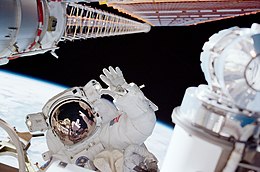 Noriega on the newly-installed P6 truss, during EVA 2 | |
| Names | Space Transportation System-97 |
|---|---|
| Mission type | ISS assembly |
| Operator | NASA |
| COSPAR ID | 2000-078A |
| SATCAT no. | 26630 |
| Mission duration | 10 days, 19 hours, 58 minutes, 20 seconds |
| Distance travelled | 7,203,000 kilometres (4,476,000 mi) |
| Spacecraft properties | |
| Spacecraft | Space Shuttle Endeavour |
| Launch mass | 120,742 kilograms (266,191 lb) |
| Landing mass | 89,758 kilograms (197,883 lb) |
| Payload mass | 7,906 kilograms (17,430 lb) |
| Crew | |
| Crew size | 5 |
| Members | |
| Start of mission | |
| Launch date | 1 December 2000, 03:06 UTC |
| Launch site | Kennedy, LC-39B |
| End of mission | |
| Landing date | 11 December 2000, 23:04 UTC |
| Landing site | Kennedy, SLF Runway 15 |
| Orbital parameters | |
| Reference system | Geocentric |
| Regime | Low Earth |
| Perigee altitude | 352 kilometres (219 mi) |
| Apogee altitude | 365 kilometres (227 mi) |
| Inclination | 51.6 degrees |
| Period | 91.7 min |
| Docking with ISS | |
| Docking port | PMA-3 (Unity nadir) |
| Docking date | 2 December 2000 |
| Undocking date | 9 December 2000 |
| Time docked | 6 days, 23 hours, 13 minutes |

 Left to right – Front: Bloomfield, Garneau, Jett; Back: Noriega, Tanner | |
STS-97 was a Space Shuttle mission to the International Space Station (ISS) flown by Space Shuttle Endeavour. The crew installed the first set of solar arrays to the ISS, prepared a docking port for arrival of the Destiny Laboratory Module, and delivered supplies for the station's crew. It was the last human spaceflight of the 20th century.